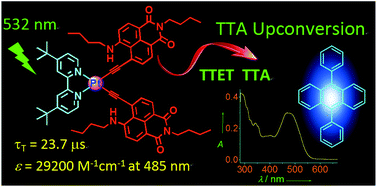The effect of the regioisomeric naphthalimide acetylide ligands on the photophysical properties of N^N Pt(ii) bisacetylide complexes†
Abstract
Two N^N Pt(II) bis(acetylide) complexes Pt-1 and Pt-2 with regioisomeric amino NI acetylide ligands (L-1 and L-2, L-1 = 5-amino-4-ethylnaphthaleneimide; L-2 = 3-amino-4-ethylnaphthaleneimide) were prepared. The photophysical properties of the complexes were studied by steady state and time-resolved spectroscopy. The two complexes with regioisomeric ligands (Pt-1 and Pt-2) show different photophysical properties such as maximal absorption wavelength (485 nm vs. 465 nm), triplet excited state lifetimes (23.7 μs vs. 0.9 μs), and different solvent-polarity dependences of the emission properties. The absorption of the complexes is red-shifted as compared with the previously reported Pt(II) complex containing the 4-ethylnaphthaleneimide ligand. The two complexes with regioisomeric NI ligands were used as triplet photosensitizers for triplet–triplet annihilation (TTA) upconversion; drastically different upconversion quantum yields (15.0% vs. 1.1%) were observed. Our results are useful for designing new visible light-harvesting Pt(II) bisacetylide complexes as triplet photosensitizers which can be used in areas such as photocatalysis, photodynamic therapy and TTA upconversion.


 Please wait while we load your content...
Please wait while we load your content...